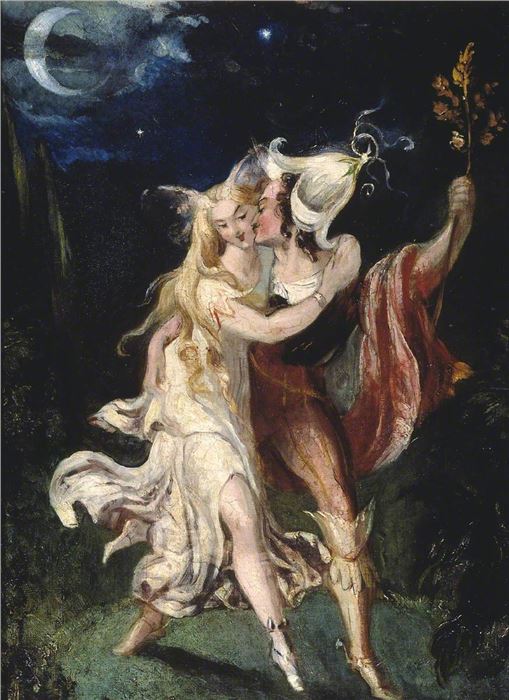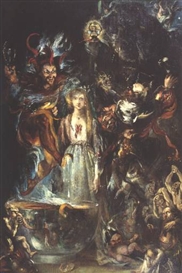The Frankenstein Artist Who Inspired Dante Gabriel Rossetti
Theodor von Holst, an overlooked Gothic artist, influenced Rossetti and the Pre-Raphaelites, beginning with his haunting 1831 illustrations for Frankenstein
Michael Pearce / 黑料不打烊
Apr 18, 2025

When he was only twenty-one, Theodor von Holst became the first artist to illustrate Frankenstein, producing for the edition of 1831 a remarkable frontispiece of the moment of the monster’s first breath, and a less successful illustration of the melancholy dawn departure of Victor Frankenstein from his beloved Elizabeth. Beneath the first etching, which captured the moment of the kindling of the electric energy of the creature’s birth the engraver scribed Shelley’s description – “By the glimmer of the half-extinguished light I saw the dull yellow eye of the creature open; it breathed hard, and a convulsive motion agitated its limbs. I rushed out of the room.”
Theodor Von Holst, (Etching William Chevalier), Frankenstein, 1831
In Von Holst’s drawing, both creator and creature looked astonished at the sudden manifestation of new life, and recoiling Frankenstein swung open the door of the cramped laboratory to flee from the desperate scene, gazed upon by skulls lining the summit of a bookshelf loaded with heavy bound tomes filled with the arcane knowledge he had used to conjure breath into his creation. Strange, arching scientific equipment glowed over the creature’s head, while moonlight poured through the leaded glass of an ecclesiastical and gothic window lighting a framed diagram hanging on the wall, copied from Henry Cornelius Agrippa’s fourth book of occult philosophy, Of Geomancy, which explained a numerological system for divination based on the astrological houses of the zodiac. Sadly, the symbols in the etching are too obscure to be reliably interpreted as prognostication for the future or character of either Dr. Frankenstein or his creature.
In his innovative drawing, Von Holst did not emphasize the monstrous and exaggerated qualities of Frankenstein’s creation that would become standard features of later imagery of the monster, but instead imagined the naked creature flexing his thin skin, exposing musculature and bone like a studio écorché model, evoking the anatomical studies of dissection rooms, contrasted with the stillness of a lifeless figure beneath, emphasizing the macabre contrast between his vibrant and novel animation and the grisly sources of his once-dead body. Frankenstein was a resurrection man in the business of grave-robbery, echoing the Orphic journey to and from the underworld, and defying death. Von Holst’s dark imagination was seized by the same occult spirit of the alchemists Cornelius Agrippa, Paracelsus, and Albertus Magnus that had gripped the creative souls of both Mary Shelley and the real monster of her invention, Victor Frankenstein.
Theodor von Holst, The Fairy Lovers, Oil on canvas, 41.3 x 31.1cm, c.1840
Born in England as the son of a German musician and a Russian mother, Von Holst’s artistic talent had been noticed when he was a teenager by a family friend, the Swiss master of horror Henry Fuseli, who gave him his earliest instruction, and some of the student’s dark and gothic imagery became almost indistinguishable from his master’s. At fourteen he became a student at the Royal Academy in 1824, where he attracted the attention and patronage of the painter Thomas Lawrence, who was then the Academy’s President, and had become Von Holst’s first customer when he bought a drawing from the ten-year-old artist for a few guineas when he found him drawing sculptures in the British Museum – Lawrence had been a child prodigy, too, and born without the benefit of wealth, and he was a generous and welcoming friend to young artists. But the bright years of patronage which seemed to be opening to Von Holst under Lawrence’s wing were cut short by both of his benefactors’ deaths – Fuseli went to his grave after a long life of good health in 1825, and Lawrence aged sixty from a heart attack in January 1830, and instead of being cared for and raised up in cultured tradition as an aristocratic courtier Von Holst was forced to fend for himself, and libertine indulgence, occultism, and romantic neo-paganism stamped their brands on his work.
He must have been re-energized by the attentions of the novelist and Member of Parliament Lytton Bulwer, who bought The Drinking Scene from Faust, and another un-named painting from him in 1832, but he got his most enduring – and disreputable – support from his friend John Ovenstone, who was “noted in his day as a dealer in old curiosities and bric-a-brac… as are to be found in the Hotel Cluny at Paris, and the Museum of Antiquities at Naples." The Scottish writer Charles Mackay said Ovenstone made an excellent living furnishing the discrete homes of courtesans and mistresses kept by rich male “protectors" with a taste for the exotic and the erotic. One of his most discrete and powerful clients was the Duke of York, who gave him a cunningly crafted and sensual automaton clock with exquisite ivory figures of Adonis and Venus concealed inside a cabinet. It is likely that Ovenstone sold Von Holst’s more suggestive drawings to clients seeking art with a provocative or unconventional aesthetic.
Theodor von Holst, Bertalda, Assailed by Spirits, Oil on canvas, 151.7 x 91.5 cm, c. 1830
Von Holst created finished paintings for a never-published edition of Charles Mackay’s poem The Maid of Mora, or the Salamandrine. Mackay purchased two of the completed canvases, probably The Forest Walk and The Watch Fire. Mackay briefly remembered the artist in his 1887 memoir, writing:
His imagination was highly poetical and graceful, though often wandering into the wild, the grotesque, and the fantastic, with a tendency, I thought, to degenerate into the extravagant, the ultra-romantic, and the supernatural. He was eccentric but picturesque in his costume, and often suggested to my mind, as I looked upon him, what his erratic predecessor, Blake, must have appeared in the eyes of his contemporaries, when the semi- or demi-semi fits of his highly poetical lunacy were upon him.
He was the owner of a human skull, mounted with a silver rim, which he used as a punch-bowl, and out of which he often, he said, drank ale or wine, and punch, when he was grimly convivial among his Bohemian comrades.
Because of his precocious ability and the endorsements of Lawrence and Fuseli, whose reputation for the dark imagery of nightmares set a worthy precedent for visionary artists for the next two centuries, journalists paid close attention to Von Holst, noticing both the inconsistency of his technique and of his subjects, which moved freely between traditional religious themes and mystical or esoteric imagery. He found his greatest enthusiasm in his visionary fantasies, and his love of his subjects was obvious to reviewers of his romantic and theatrical work. With only Ovenstone as a consistent patron, Von Holst had nothing to lose, and flew headlong into creating paintings of religious sentiment, erotica, and a flood of images inspired by Goethe’s pagan occultism. The critics recognized the inconsistency of his work.
Theodor Von Holst, (engraved by Emily Sartain), Christ raising Jairus' daughter, Mezzotint, 1866
In 1844, Von Holst died, a bohemian martyr aged only thirty-four, fulfilling his tragic destiny by following the model of self-destruction set by Thomas Chatterton. He was carried to death by ‘liver failure’ suggesting either a life poisoned by alcoholism, or epidemic jaundice (hepatitis). A friend, perhaps the writer Franklin Fox, described Von Holst in an obituary in The People’s Journal as a disappointed genius, whose “temper was soured by seeing inferior spirits raised to affluence and honor; to hear their fame from every tongue; to see their works multiplied by the means of engraving to almost infinitude, staring from every print shop window throughout the land, and to feel himself unnoticed, unappreciated.” The Art-Union published half a page of obituary to him in 1844, acknowledging the difficulty he had faced as a genius without patronage, and blaming Lawrence for corrupting his young student by commissioning provocative drawings from him for the collection of King George IV – such immoral profit had set Von Holst on the primrose path of pleasure.
Theodor Von Holst, The Wish, Oil on Canvas, 45.9 x 37.9 cm, 1840
Although he perished unaware of his importance, Von Holst provided a model of resistance for the young members of the Pre-Raphaelite Brotherhood to follow. The enthusiastic young brotherhood insisted that art after Raphael was corrupted by virtuosity, and emulated the painters of the honest renaissance, seeing in Von Holst a romantic hero of defiance to the champions of convention, who they recognized in the leaders of the Royal Academy. In the earlier days of their association Rossetti and his fraternal clique liked socializing at Campbell's Scotch Stores, a popular tavern and lunchroom, with a retail wine and spirit department and an airy coffee shop which exhibited Von Holst’s drawings. It is pleasantly tempting to imagine some of Von Holst’s pen and ink and watercolor images of drinking scenes at Auerbach’s Tavern, or some of his melodramatic images of Faust, Mephistopheles, and Gretchen finding their way onto the walls of Campbell's to tease the dallying eyes of the young brotherhood. Certainly, Rossetti was inspired to write his first poem The Card-Dealer in a fit of lyrical enthusiasm brought on by Von Holst’s gypsy painting of a tarot-card reader, The Wish, and acquired one of the artist’s sketchbooks. Rossetti was fascinated by the painting, taking its sensual and vampirish imagery as a guide to his own alluring and erotic pictures of beautiful, long-necked women under the spell of Von Holst’s gothic mood of magic, Mephistopheles, and the night.
For more on auctions, exhibitions, and current trends, visit our Magazine Page







, Frankenstein, 1831.Jpeg)


, Christ raising Jairus' daughter, Mezzotint, 1866.Jpeg)


